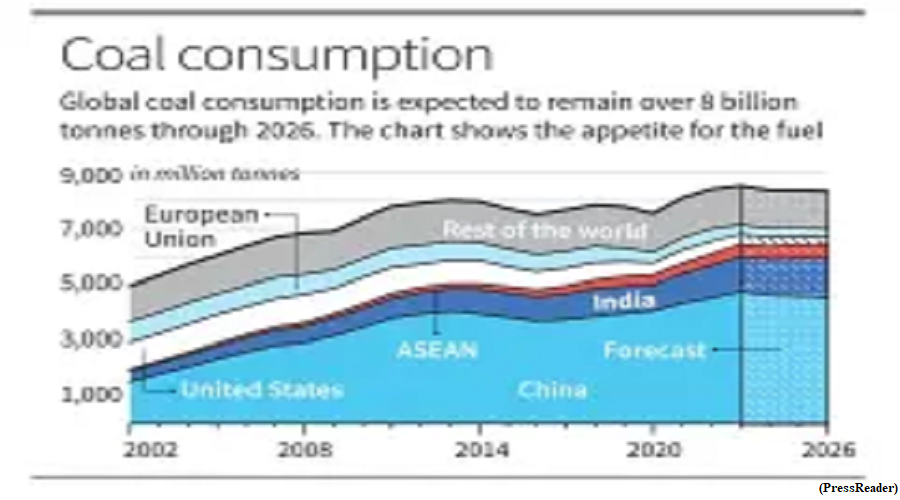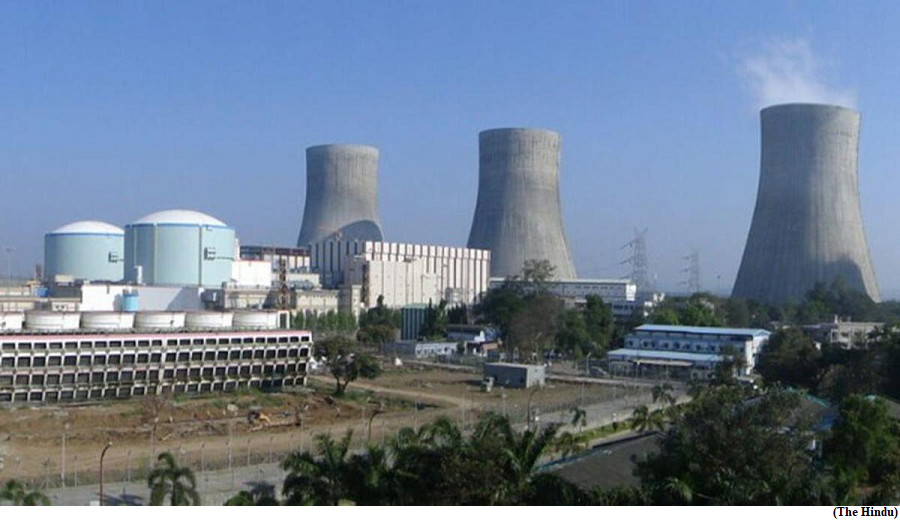Global coal demand likely to decline 2.3 percent by 2026, IEA (GS paper 3, Economy)

Why in news?
- Despite production of coal reaching a record in 2023, global demand is expected to decline by 2026, a report by the International Energy Agency (IEA) says.
- While the decline is expected to be due to a shift towards renewable energy and plateauing demand in China, India will remain the “driving force” for the fuel until that year.
Key Highlights:
- The report sees the global demand for coal rising by 1.4% in 2023, surpassing 8.5 billion tonnes for the first time. This increase, however, masks stark differences among regions.
- While demand in the European Union and United States is expected to drop by 20% each, it is expected to rise by 8% in India and 5% in China in 2023 due to demand for electricity and diminished generation of hydroelectric power.
- Currently, a little over half the world’s coal demand comes from China. With a major expansion of renewable energy expected, coal demand in the country is expected to fall in 2024 and plateau in 2026. Overall, this will result in a 2.3% fall in global coal demand by 2026.
Factors for decline in coal demand:
- The IEA’s expectations of a decline in coal demand is premised also on a change in global climate.
- The current El Nino conditions, usually linked with a drier monsoon in Asia, are expected to turn to La Nina, which is generally linked to better rainfall, between 2024 and 2026. This will presumably translate to greater hydroelectric power output.
- Moreover, a steep upward trend in low-cost solar photovoltaic deployment is expected to aid renewable power generation.
Global demand:
- Coal, the most important energy source for electricity generation, steel-making, and cement production, is also the largest source of carbon dioxide (CO2) emissions from human activity.
- Despite forecasts of a fall, global consumption is expected to remain well over 8 billion tonnes through 2026.
Coal emissions:
- Reducing use of ‘unabated’ coal, or coal-burning without technologies to capture carbon, is among the explicit agreements of countries signatory to the United Nations Framework Convention on Climate Change, the world’s biggest influencer of climate policy.
- To have a chance at keeping temperatures from rising beyond 1.5 degrees Celsius by the end of the century, coal emissions must decline nearly 95% between 2020 and 2050.
Fact:
- China, India, and Indonesia are expected to break output records in 2023, pushing global production to a new high in 2023. These three countries now account for more than 70% of the world’s coal production.
House panel pulls up Centre over delay in framing rules for Acts passed by Parliament
(GS paper 2, Polity and Constitution)
Why in news?
- The Subordinate Legislation Committee of the Rajya Sabha, headed by BJP MP Laxmikant Bajpayee, has pulled up the Centre for the delay in framing of rules/regulations for the Acts passed by Parliament.

Key Highlights:
- The panel said that delay by the Union Ministries in the framing of rules has become a recurring problem.
- Framing rules, a duty of the Executive, is supposed be done within six months of passing the Act, and the government must table the rules of an Act in Parliament.
- On the National Food Security Act of 2013, the report said even after the Act came into force about 10 years ago, the rule-making process had been stuck up, especially on the part of State governments. Delhi, Rajasthan and Uttarakhand are yet to complete the process.
- Similarly, on the rules of Arbitration and Conciliation (Amendment) Act, the panel said four years had lapsed without any progress when so much importance was being given to ease of doing business.
Concerns:
- The Committee feels that the delay in framing the rules/regulations defeats the very purpose of enactment of the Acts as the Acts cannot be operated in the absence of the Rules/Regulations.
- It also cited its 1971 report that said if the rules were not framed within six months, the Secretary should inform the Minister concerned and obtain his orders.
Indigenously built Unit-4 at Kakrapar attains criticality
(GS paper 3, Science and Technology)
Why in news?
- The fourth unit of the Kakrapar Atomic Power Project (KAPP) in Gujarat started controlled fission chain reaction and thus became critical recently.
- The project’s units with a capacity of 700 MWe each are the largest indigenous nuclear power reactors to be built by Nuclear Power Corporation of India Ltd. (NPCIL), a public sector undertaking of the Department of Atomic Energy.

Unit-3 of the KAPP:
- Unit-3 of the KAPP started generating commercial electricity from August 30. These reactors are pressurised heavy water reactors (PHWRs), which use natural uranium as fuel and heavy water as coolant and moderator.
- The NPCIL is already operating indigenous PHWRs with 220-MWe and 540-MWe capacity at other facilities.
- The reactor’s first criticality was ascertained after it met all the conditions set out by the Atomic Energy Regulatory Board (AERB), India’s nuclear safety watchdog.
PHWRs at Kakrapar Atomic Power Station:
- The Kakrapar Atomic Power Station already has two operating PHWRs with a capacity of 220 MWe each, called KAPS-1 and -2.
- The indigenously built 700-MWe reactors are among “the best reactors of this PHWR category”.
- They have many advanced safety features, including among others a steel-lining from the floor to the wall and a passive decay heat removal system to cool the fuel core.
Fact:
- The NPCIL at present operates 23 nuclear electricity reactors with a total capacity of 7,480 MWe. It has nine units, including KAPP-4, under construction while 10 more reactors, with a total capacity of 7,000 MWe, are in the pre-project phase.




